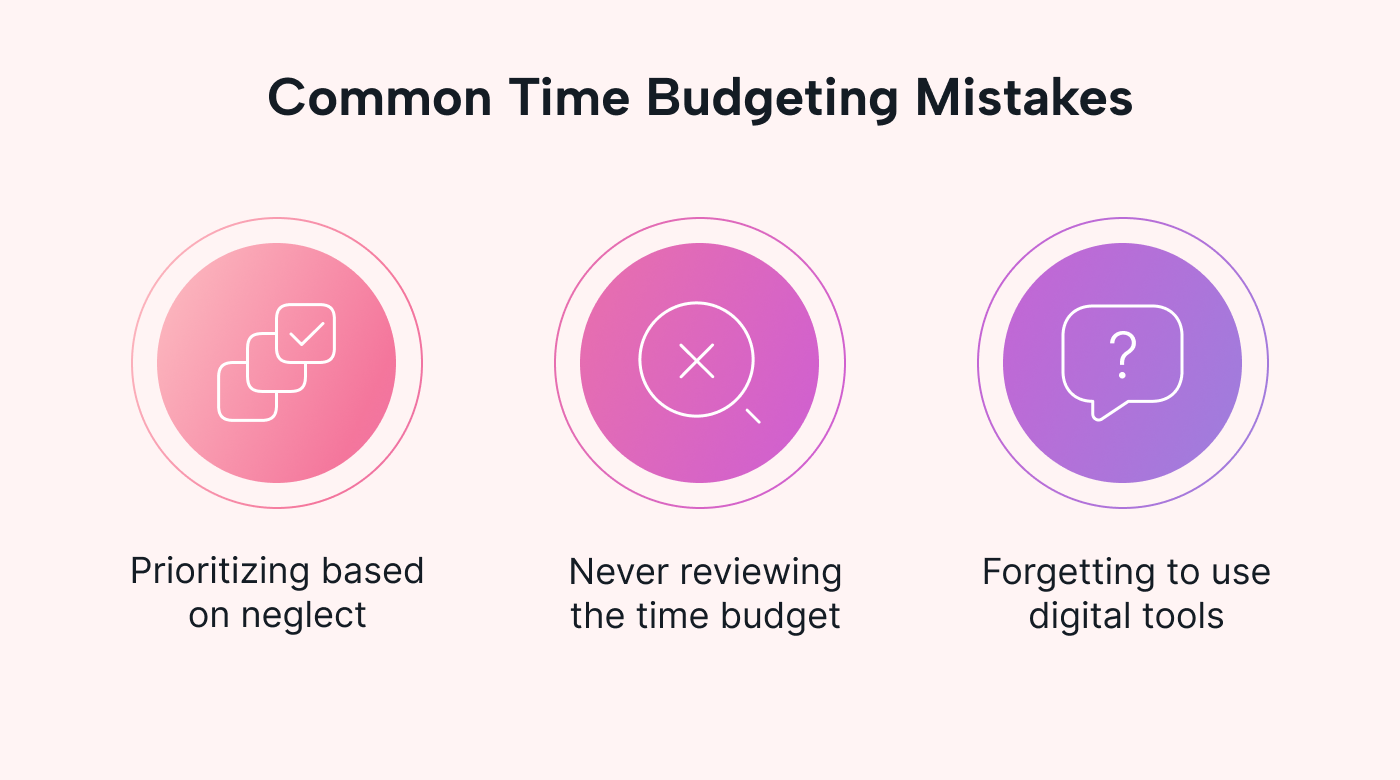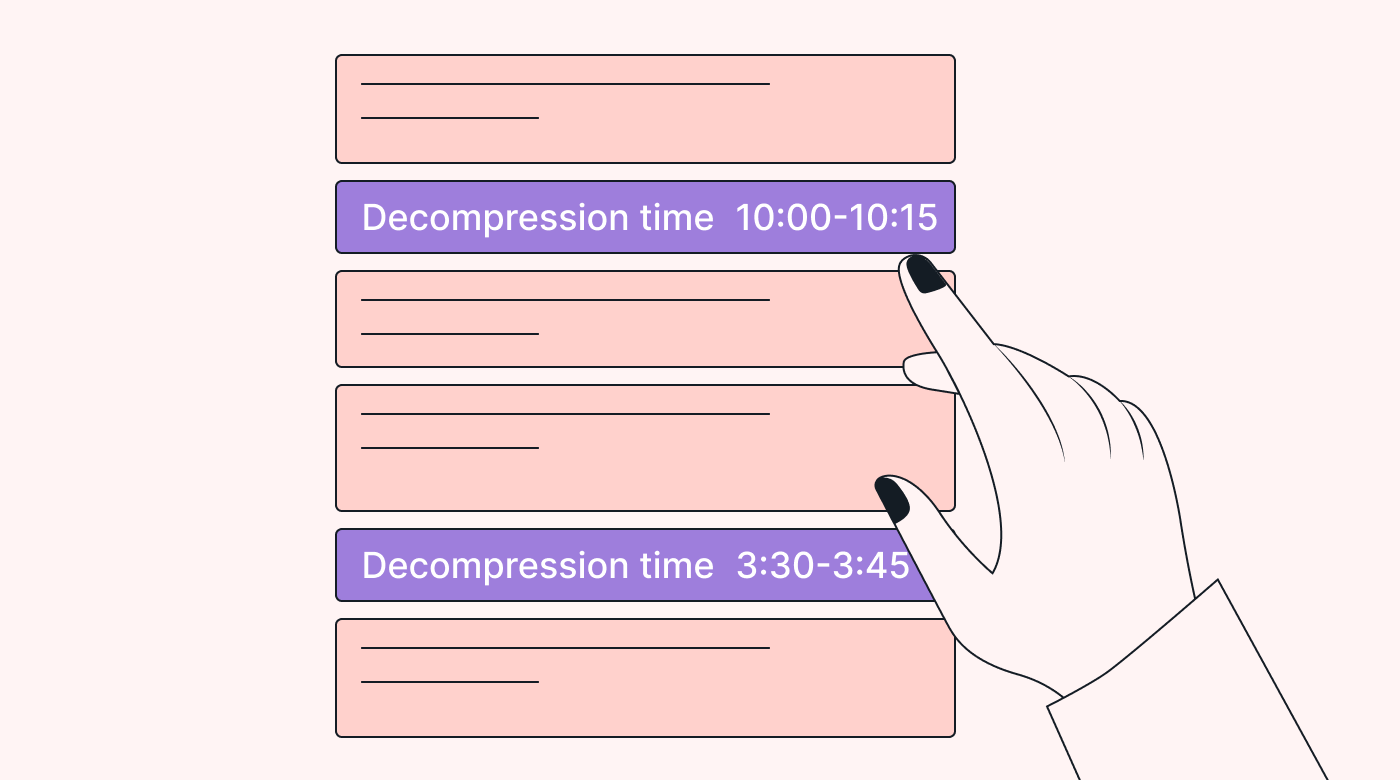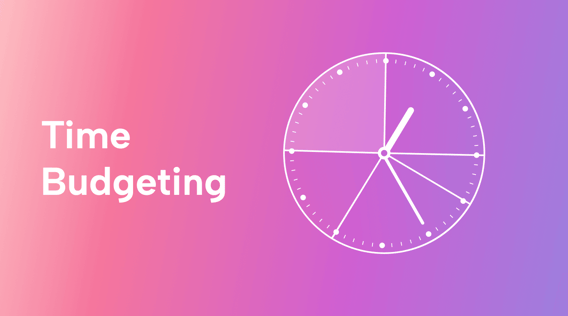If you’re like most working professionals, you’re familiar with the sense of horror that creeps in when you realize you’re running out of time and have barely made a dent in your to-do list.
It feels like there aren’t enough hours in the day to reach your goals, and there’s nothing you can do about it.
But what if we told you that there are enough hours in a day? You just don’t know how to manage them yet.
Time budgeting is a time management technique where you plan how you want to “spend” your time throughout the week. Just as a financial budget helps you take control of your finances, a time budget helps you regain control of your productivity and priorities.
In this article, we explore the benefits of time budgeting and provide actionable tips to help you create an effective budget for your time.
Benefits of time budgeting
Time management methods enable you to take control of your workday by helping you build healthy habits and increase your awareness of the things that impede your focus.
Besides giving you a solid plan to work from at the start of each work day, here are the top advantages to time budgeting:
- No more missed deadlines. When you manage your time well, you’re more likely to stay on top of your workload and meet your deadlines. You’ll set aside enough time to complete tasks or have the foresight to ask for extra time before you run into trouble.
- Increased consistency. Regularly practicing time budgeting builds a couple of important habits: intentional planning and forward thinking. As you strengthen these habits, you’ll find that you’re more motivated and productive.
- Decreased stress. Forty-four percent of workers experience high levels of stress at work. Time budgeting helps reduce stress by making sure you’re organized and prepared but still flexible enough to cope with last-minute changes to your schedule.
- Increased self-awareness. Time budgeting encourages self-performance analysis by forcing you to look objectively at your work habits.
- Identification of productivity and time killers. When constructing your time budget, you have an opportunity to perform a time audit that identifies tasks or distractions that throw off your performance.
How to build a time budget in 3 easy steps
The initial process of building a time budget isn’t complicated — it boils down to the following three steps:
1. Define your priorities
A time budget is useless unless it accurately reflects your work priorities.
Schedule a weekly review of your to-do list to identify which tasks require the most attention and the highest skill level. Take note of each task’s deadline and urgency level to help you pinpoint high-priority tasks you need to focus on.
2. Allocate time
Set aside a block of time that matches each task’s duration. The more skill and effort a task requires, the more time you should allocate to that task.
Don’t forget to set aside additional time between tasks (called “buffer time”), time for breaks and rest, and time for traveling between places.
Related: How to Make a Schedule in 6 Steps
3. Follow your budget
Now that your time is distributed, all that’s left to do is follow your plan.
Track your time and make notes of how long you spend on each task. After a couple of weeks, you’ll have a solid understanding of how much time to set aside for different activities, including leisure activities, critical tasks, unimportant tasks, and even household chores.
Adjust your time budget as necessary to accurately reflect the way you spend your time and accommodate changes to your priorities or daily routine.
Pro tip: Insert your time budget into a digital calendar so that you can access your plan from anywhere and at any time.
3 common mistakes when time budgeting
The vast majority of people try their best to plan effectively, but they put their effort and attention in the wrong places. And after enough failed attempts at time management, they’re left demotivated and frustrated.
Here are the three most common mistakes that people make when they first start time budgeting:
 |
1. Using neglect-based prioritization
When time budgeting, you can choose to take a proactive approach, where you anticipate your future needs and act accordingly, or a reactive approach, where you respond to needs as they appear.
In neglect-based prioritization, you only set aside time for something when you’ve neglected it or if it’s the most-neglected of your tasks. The problem with this approach is that you’re constantly in a reactive state — so you never get to plan ahead.
Instead of using neglect-based prioritization, think ahead and anticipate your future needs. This may take some practice as you learn to analyze how you spend your time.
2. Never reviewing your budget
Your time budget needs to grow and change with your schedule, responsibilities, and priorities. It’s impossible to improve your time budget template each week unless you know how well the previous daily time budget worked for you.
Use a time tracking app, and take note of whether your proposed time budget is accurate and helpful. As you learn more about your time-spending habits, you’ll create increasingly effective plans.
Make a plan to review your budget at the end of every day or week to stay on top of your progress.
3. Not using digital tools
Working professionals are no strangers to the phrase, “There’s an app for that.” And there are, indeed, many apps that can help you with time budgeting.
Relying on digital tools to store, manage, or create your time budgets saves you time and energy that you can channel toward high-effort tasks and deep work.
Instead of avoiding technology, incorporate digital planning tools to reduce the heavy lifting of manual planning and speed up your time management process.
5 best tips for time budgeting
Now that you know the basic steps for creating accurate time budgets and the most common mistakes to avoid, you can dive into optimizing and customizing your time-spending plan.
Here are five tips for taking your time budget to the next level:
1. Create flexible priorities
It’s rare for one area of your life to always take priority over others. If you’re choosing between a low-priority task at work and driving a family member to the hospital, the latter will obviously come first. But if you’re choosing between fixing a crashed server that’s essential for your company to function and mowing the lawn, your work can come before your personal life.
Instead of creating a hard-and-fast rule that one area always trumps another, allow yourself to have flexible priority levels by looking at things on a case-by-case basis.
2. Don’t over budget
Although it might feel like your productivity will skyrocket if you plan out every second of your day, it can actually have the opposite effect. When time budgeting, start conservatively by only budgeting for around 50% of your time.
As you gain confidence in your time allocations and routine, you can increase the number of hours you account for in your budget.
3. Create time buffers between tasks
Time buffers are small pockets of unaccounted-for time that you schedule between other time blocks. They hold space for longer completion times, unexpected tasks, and simply resting between activities.
 |
If every second of your day is accounted for, small adjustments to your routine can drastically throw you off your schedule. Time buffers help you stay on track even if you take an unscheduled phone call with a loved one or get stuck in traffic on the way to work.
4. Don’t budget too far in the future
Your time budget is a living, moving thing, so you’ll adjust it frequently as you accommodate new priorities and get used to the system. Budgeting within a wide time frame is often a waste of time because there’s such a high chance that your plans will change.
Stick to budgeting one week at a time, and regularly review your budget to make any necessary adjustments.
5. Automate as much of your planning as possible
When you’re used to working within your time budget, you can start automating your planning to streamline the entire process.
Motion is an intuitive and versatile AI-powered digital calendar that helps you manage your everyday life. It automatically plans your day for you based on variables such as deadlines, working hours, task links, and resource meetings.
You can use your Motion calendar to schedule anything from your daily scrum meetings to your ideal number of hours of sleep per night.
Along with creating an optimized daily plan for you:
- Motion’s deadline management functionality alerts you if you’ve overbooked your time and are in danger of missing a deadline.
- The app’s anti-destruction system keeps your time on social media concise and productive.
- Motion seamlessly integrates with Google or Microsoft calendars.
- Motion’s scheduler tab allows you to create time blocks that you want to keep free for meetings.
Take control of your time with Motion
Knowing how to proactively budget your time unlocks consistent and sustainable productivity. Whether you’re constantly missing deadlines or simply feeling overwhelmed by your to-do list, you can take control by time budgeting.
If you’re ready to unlock the power of time budgeting, Motion can help you.
Motion takes everything you need to do and uses AI to automatically create an optimized daily schedule. It makes time budgeting a breeze, expanding what you have available each week so that it feels like you have 13 months in a year.
With Motion, there are no more missed deadlines, no more overwhelming to-do lists, and no more chaos. Get started for free today.





